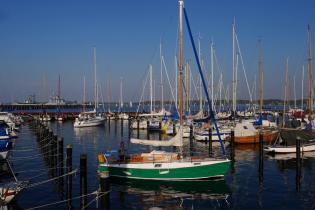
Emergency plans for Marinas can help to be better prepared for storm floods. In preparing an emergency plan, certain information has to be provided.
Storms and floods can always be a risk for marina – they even can happen at unexpected times like happened at the summer storm flood in summer of 1989 in the Bay of Kiel area. This unusual summer event caused a lot of damage to the Marinas in this area. (More on the event can be found the Risc-Kit site here.)
The development of an emergency plan can help to be better prepared for such events. An emergency plan should consist of different sections. These ideas are based on the Clean Marina Classroom developed by the University of Michigan, USA. Each emergency response plan should contain the following information:
1. Where:
- In the very front of the plan, insert a laminated site plan of the facility showing valves, pipes, tanks, structures, roads, hydrants, docks, power and fuel shutoffs, hazardous material storage locations, and telephones.
- Describe where response material is located.
2. Who:
- Identify who is responsible (i.e., the assigned staff position) for taking what action, including deploying equipment, contacting emergency agencies.
- Designate one marina staff person as the official spokesperson for the facility.
- Include a list of emergency phone numbers: Coast Guard, state officials; local fire and police departments; the marina owner; neighboring marinas that have emergency response equipment; and spill response contractors.
- Include a brief description of each agency’s jurisdiction and information about what type of equipment and services are available from neighboring marinas and spill response firms.
3. What:
- State what action should be taken during an emergency and, based on likely threats, what equipment should be deployed.
- Include information about what type of equipment is available onsite and what its characteristics and capabilities are.
- Characterize the facility’s waterfront and vessels.
- Describe the type, amount and location of materials stored onsite, e.g., petroleum and hazardous materials. This will help first responders know what chemicals may be released when materials burn or are spilled.
- Include plans for oil/waste disposal and decontamination.
4. How:
- Explain how equipment should be used and how materials should be disposed. A waste disposal contractor can handle these wastes; identify this entity in your plan. Decontamination procedures are also important so that other areas of marina (and people) are not contaminated with oily wastes. This may be as simple as a designated wash down area to control access and departure from spill (hot zone) area and to collect oily coveralls and boots. Also, there should be a safety plan (part of emergency response plan) that ensures responders are trained, aware of potential risks and provided with appropriate personal protective equipment. Finally, plans should identify available response resources, call for hands-on training and drills, and address the need to replenish all used supplies and safety gear as necessary.
5. When:
- Indicate when additional resources should be called for assistance.
- Update the plans annually to include any new technology or equipment and to confirm phone numbers.
- Carryout and record scheduled employee training for implementing the plan.
Additionally it is important to keep the emergency plans accessible. Copies of the plans should be kept in readily accessible locations. It is also important to share these plans with important stakeholder. For example the local fire department and local emergency services should be informed about the plans and given an additional copy. This will allow them to provide prompter assistance. A regular information exchange with neighboring marinas (exchange of contact data, information about resources, etc.), could be a valuable aspect in case of emergency.
This tool for preparedness is important for every marina, since it also rather simple and inexpensive to set up. But the plan is only as good as it would be executed during an extreme event. Therefore are regular update of the plan and regular emergency drills are necessary.









